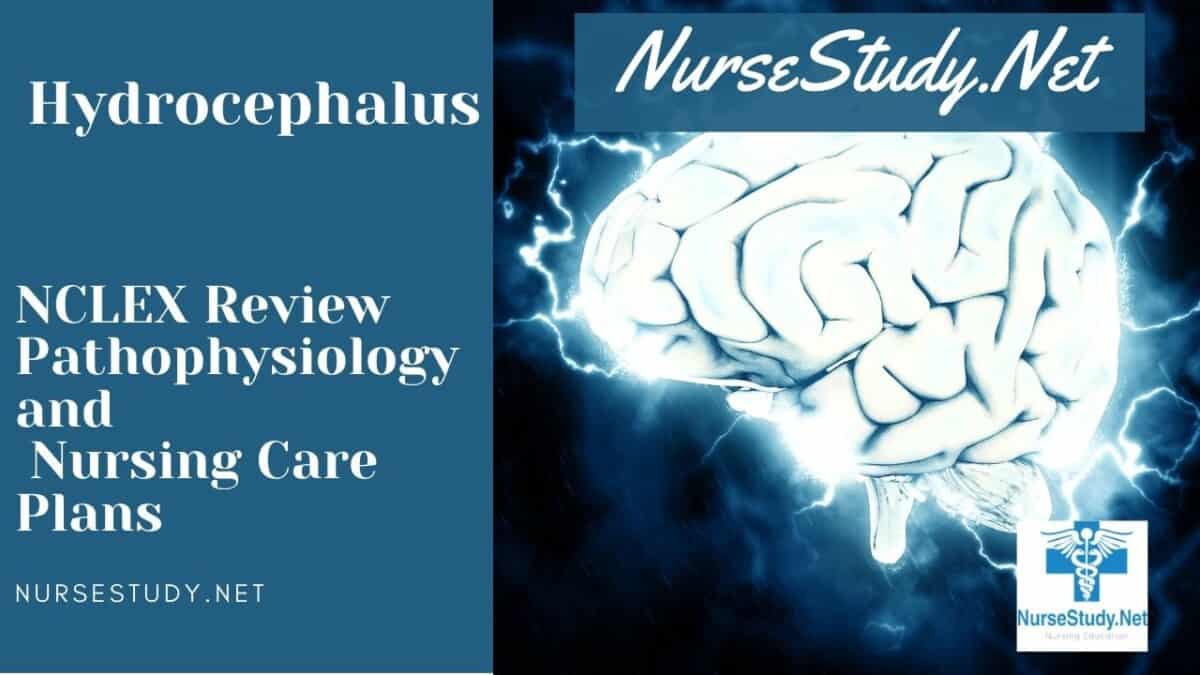Hydrocephalus is a condition characterized by abnormal accumulation of cerebrospinal fluid (CSF) in the brain’s ventricles, causing increased intracranial pressure. This nursing diagnosis focuses on identifying symptoms, preventing complications, and providing comprehensive care for patients with hydrocephalus.
Causes (Related to)
Hydrocephalus can develop from various factors affecting CSF production, flow, or absorption:
- Congenital conditions
- Brain tumors
- Head trauma
- Infections (meningitis, encephalitis)
- Subarachnoid hemorrhage
- Inflammatory conditions
- Post-surgical complications
Signs and Symptoms (As evidenced by)
Subjective: (Patient reports)
- Headache
- Nausea and vomiting
- Vision problems
- Balance difficulties
- Memory issues
- Cognitive changes
- Urinary incontinence
- Fatigue
Objective: (Nurse assesses)
- Increased head circumference (in infants)
- Bulging fontanelle
- Setting-sun sign
- Papilledema
- Altered mental status
- Gait disturbances
- Changes in vital signs
- Decreased level of consciousness
Expected Outcomes
- The patient will maintain stable intracranial pressure
- The patient will demonstrate improved neurological status
- The patient will maintain proper shunt function (if present)
- The patient will avoid complications
- Patient will demonstrate an understanding of condition management
- The patient will maintain optimal cognitive function
- Patient will achieve the maximum level of independence
Nursing Assessment
Monitor Neurological Status
- Assess the level of consciousness
- Check pupillary response
- Evaluate motor function
- Monitor cognitive status
- Document behavioral changes
Evaluate Shunt Function
- Check for signs of malfunction
- Monitor CSF drainage
- Assess insertion site
- Document drainage characteristics
- Note any neurological changes
Monitor Vital Signs
- Track blood pressure
- Assess heart rate
- Monitor respiratory rate
- Check temperature
- Document trends
Assess for Complications
- Monitor for infection signs
- Check for increased ICP
- Evaluate for shunt failure
- Assess for seizure activity
- Monitor for hydration status
Nursing Care Plans
Nursing Care Plan 1: Risk for Increased Intracranial Pressure
Nursing Diagnosis Statement:
Risk for Increased Intracranial Pressure related to altered CSF flow and absorption as evidenced by the presence of hydrocephalus.
Related Factors:
- Altered CSF dynamics
- Presence of a shunt device
- Underlying medical conditions
- History of brain injury or infection
Nursing Interventions and Rationales:
- Monitor neurological status q2h
Rationale: Early detection of increased ICP signs - Maintain head elevation at 30-45 degrees
Rationale: Promotes venous drainage and reduces ICP - Monitor vital signs and trends
Rationale: Identifies Cushing’s triad early
Desired Outcomes:
- The patient will maintain stable ICP
- The patient will show no signs of neurological deterioration
- The patient will maintain adequate cerebral perfusion
Nursing Care Plan 2: Impaired Physical Mobility
Nursing Diagnosis Statement:
Impaired Physical Mobility related to neurological impairment as evidenced by gait disturbances and balance problems.
Related Factors:
- Altered neurological function
- Muscle weakness
- Balance impairment
- Visual disturbances
Nursing Interventions and Rationales:
- Assess mobility capabilities daily
Rationale: Determines appropriate assistance level - Implement fall prevention measures
Rationale: Prevents injury from impaired balance - Provide assistive devices as needed
Rationale: Promotes safe mobility
Desired Outcomes:
- The patient will demonstrate safe mobility
- The patient will maintain optimal independence
- The patient will avoid falls
Nursing Care Plan 3: Risk for Infection
Nursing Diagnosis Statement:
Risk for Infection related to the presence of CSF shunt device as evidenced by surgical intervention and invasive procedure.
Related Factors:
- Presence of foreign body (shunt)
- Surgical intervention
- Compromised protective barriers
- Altered CSF flow
Nursing Interventions and Rationales:
- Monitor shunt site and incision
Rationale: Early detection of infection signs - Maintain sterile technique
Rationale: Prevents contamination - Monitor temperature trends
Rationale: Identifies infection early
Desired Outcomes:
- The patient will remain free from infection
- The patient will maintain a normal temperature
- Wound sites will heal appropriately
Nursing Care Plan 4: Deficient Knowledge
Nursing Diagnosis Statement:
Deficient Knowledge related to complex medical condition as evidenced by questions about self-care and management.
Related Factors:
- Complex medical condition
- Lack of exposure to information
- Misconceptions about condition
- Anxiety about management
Nursing Interventions and Rationales:
- Provide education about the condition
Rationale: Increases understanding and compliance - Teach shunt monitoring
Rationale: Enables early problem detection - Demonstrate care techniques
Rationale: Promotes self-management skills
Desired Outcomes:
- The patient will verbalize understanding of the condition
- The patient will demonstrate proper care techniques
- The patient will identify warning signs
Nursing Care Plan 5: Anxiety
Nursing Diagnosis Statement:
Anxiety related to a chronic medical condition as evidenced by expressed concerns about prognosis and management.
Related Factors:
- Uncertain prognosis
- Complex medical management
- Changes in health status
- Fear of complications
Nursing Interventions and Rationales:
- Assess anxiety level
Rationale: Determines appropriate interventions - Provide emotional support
Rationale: Reduces anxiety and promotes coping - Include family in care planning
Rationale: Strengthens support system
Desired Outcomes:
- The patient will demonstrate reduced anxiety
- The patient will utilize effective coping strategies
- The patient will verbalize feelings appropriately
References
- Hochstetler A, Raskin J, Blazer-Yost BL. Hydrocephalus: historical analysis and considerations for treatment. Eur J Med Res. 2022 Sep 1;27(1):168. doi: 10.1186/s40001-022-00798-6. PMID: 36050779; PMCID: PMC9434947.
- Koleva M, De Jesus O. Hydrocephalus. [Updated 2023 Aug 23]. In: StatPearls [Internet]. Treasure Island (FL): StatPearls Publishing; 2024 Jan-. Available from: https://www.ncbi.nlm.nih.gov/books/NBK560875/
- Mazzola CA, Choudhri AF, Auguste KI, Limbrick DD Jr, Rogido M, Mitchell L, Flannery AM; Pediatric Hydrocephalus Systematic Review and Evidence-Based Guidelines Task Force. Pediatric hydrocephalus: systematic literature review and evidence-based guidelines. Part 2: Management of posthemorrhagic hydrocephalus in premature infants. J Neurosurg Pediatr. 2014 Nov;14 Suppl 1:8-23. doi: 10.3171/2014.7.PEDS14322. PMID: 25988778.
- Pindrik J, Schulz L, Drapeau A. Diagnosis and Surgical Management of Neonatal Hydrocephalus. Semin Pediatr Neurol. 2022 Jul;42:100969. doi: 10.1016/j.spen.2022.100969. Epub 2022 Apr 8. PMID: 35868728.
- Sandoval JI, De Jesus O. Hydranencephaly. [Updated 2023 Aug 23]. In: StatPearls [Internet]. Treasure Island (FL): StatPearls Publishing; 2024 Jan-. Available from: https://www.ncbi.nlm.nih.gov/books/NBK558991/
